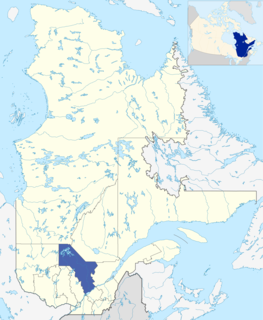| Le Haut-Saint-Maurice | |
|---|---|
| Regional county municipality | |
 The former Le Haut-Saint-Maurice RCM | |
| Coordinates: 47°26′N72°47′W / 47.433°N 72.783°W Coordinates: 47°26′N72°47′W / 47.433°N 72.783°W [1] | |
| Country | |
| Province | |
| Region | Mauricie |
| Effective | January 1982 [1] |
| Dissolved | March 25, 2003 |
| County seat | La Tuque |
| Government | |
| • Type | Prefecture |
| Area [1] [2] | |
| • Total | 29,662 km2 (11,453 sq mi) |
| • Land | 26,350.12 km2 (10,173.84 sq mi) |
| Population (2001) [2] | |
| • Total | 15,862 |
| • Density | 0.6/km2 (2/sq mi) |
| • Change (1996–2001) | |
| • Dwellings | 6,895 |
| Time zone | EST (UTC−5) |
| • Summer (DST) | EDT (UTC−4) |
| Area code(s) | 819 |
Le Haut-Saint-Maurice Regional County Municipality was a former regional county municipality and census division in the Mauricie region of Quebec, Canada. [1] It was formed on January 1, 1982, and dissolved on March 26, 2003, when it was amalgamated in its entirety into the new City of La Tuque. [3] The La Tuque census division, a territory equivalent to a regional county municipality, is contiguous with the former Le Haut-Saint-Maurice RCM.
The term regional county municipality or RCM is used in Quebec to refer to one of 87 county-like political entities. In some older English translations they were called county regional municipality.

The census geographic units of Canada are the administrative divisions defined and used by Canada's federal government statistics bureau Statistics Canada to conduct the country's five-yearly census. They exist on four levels: the top-level (first-level) divisions are Canada's provinces and territories; these are divided into second-level census divisions, which in turn are divided into third-level census subdivisions and fourth-level dissemination areas.

Mauricie is a traditional and current administrative region of Quebec. La Mauricie National Park is contained within the region, making it a prime tourist location. The region has a land area of 35,855.22 km² and a 2006 census population of 258,928 residents. Its largest cities are Trois-Rivières and Shawinigan.
Based on the last census prior to its dissolution, Le Haut-Saint-Maurice consisted of: [2]
| Name | Type/status | Land area in km2 | 2001 population | 1996 population |
|---|---|---|---|---|
| La Tuque | Ville | 579.46 | 11,298 | 12,102 |
| La Bostonnais | Municipality | 287.37 | 529 | 524 |
| La Croche | Municipality | 400.56 | 549 | 539 |
| Lac-Édouard | Municipality | 916.23 | 137 | 155 |
| Parent | Village municipality | 34.81 | 326 | 387 |
| Kiskissink | Unorganized territory | 1,860.44 | 10 | 14 |
| Lac-Berlinguet | Unorganized territory | 939.70 | 0 | 0 |
| Lac-des-Moires | Unorganized territory | 113.34 | 0 | 0 |
| Lac-Pellerin | Unorganized territory | 58.70 | 0 | 0 |
| Lac-Tourlay | Unorganized territory | 38.02 | 0 | 0 |
| Obedjiwan | Unorganized territory | 7,255.14 | 64 | 48 |
| Petit-Lac-Wayagamac | Unorganized territory | 644.36 | 0 | 0 |
| Rivière-Windigo | Unorganized territory | 13,182.20 | 241 | 204 |
| Totals * | 26,350.12 | 15,862 | 16,293 |
- * Totals include the three native reserves of Coucoucache, Wemotaci, and Obedjiwan, but were not administratively part of the RCM.
Following a 2004 referendum, the municipalities of La Bostonnais and Lac-Édouard separated from La Tuque and were reestablished on January 1, 2006. They are no longer incorporated within any regional county municipality, but remains part of the urban agglomeration of La Tuque.

La Bostonnais is a municipality in the Mauricie region of the province of Quebec in Canada. The community is about 10 kilometres (6.2 mi) north of La Tuque's town centre along Quebec Route 155.

Lac-Édouard is a municipality in the Mauricie region of the province of Quebec in Canada. Its village centre is located along the Canadian National Railway at the north end of the eponymous Lake Édouard.










